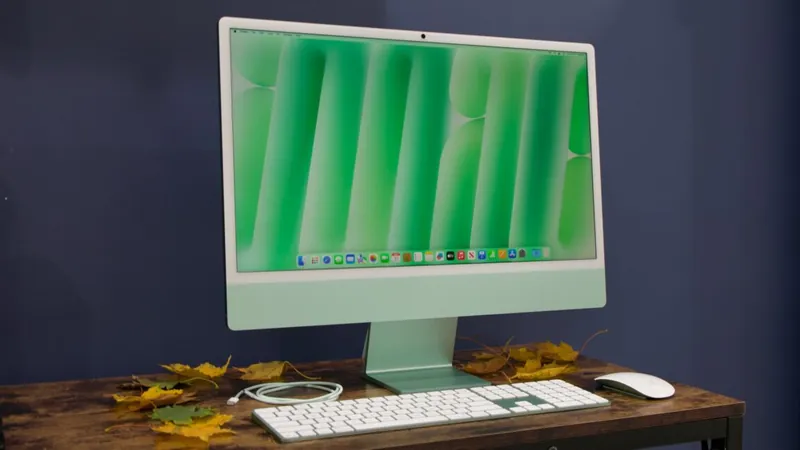
The M4 iMac: A Nostalgic Nod and a New Era Unfolds
2024-11-07
Author: Kai
The M4 iMac: A Nostalgic Nod and a New Era Unfolds
The M4 iMac presents itself as a polished, aesthetically pleasing computer that marries modern technology with a hint of nostalgia. With the base model now featuring 16GB of RAM for $1,299, Apple has made this device much more accessible and appealing for everyday users who want a seamless out-of-the-box experience. Notable changes include a transition to USB-C accessories, completely phasing out the last of the Lightning ports, which marks a significant step in Apple's tech evolution.
Visually, the new iMac continues to offer vibrant color options reminiscent of the iconic Bondi Blue plastic designs from the late 1990s, maintaining that signature aluminum-and-glass look that defines modern Apple products. One noteworthy feature is the optional $200 nano-texture display, which adds an extra layer of sophistication and minimizes glare, although many users may find the additional cost somewhat frustrating for a matte finish.
The performance improvements of the M4 are subtle yet meaningful; it isn't going to break speed records, but it gets the job done efficiently. With a fully enabled 10-core version, the M4 matches the performance benchmarks of a recent Intel Core i5 or AMD Ryzen 5 desktop CPU while consuming significantly less power. For most users focused on browsing, emailing, and standard office tasks, this version strikes a favorable balance between capability and efficiency.
In terms of specific performance metrics, the M4 boasts a single-core CPU performance increase of 14 to 21 percent compared to its predecessor, the M3, with multi-core performance gains hovering around 20 to 30 percent. Its graphical enhancements are also noteworthy; at times, the GPU can outperform the M3 by as much as 33 percent, although the improvements tend to be more modest in consistent testing.
Reminiscing About the 27-inch iMac
The iMac has long held a special place in the hearts of professional and casual users alike, particularly the 27-inch model that dominated the creative landscape during the Intel era. This larger model not only offered superior performance but also allowed users to upgrade their RAM—something subsequent models have restricted. The 5K display of the 27-inch iMac was groundbreaking, setting a new standard for desktop monitors during its time.
This powerhouse even gave rise to the iMac Pro in 2017, designed specifically for users who felt left behind by Apple's Mac Pro. Despite the stunning design of the newer 24-inch M1 iMac, it has limitations that make it unsuitable for users requiring greater screen real estate and flexibility, especially those who rely on Windows compatibility, a feature that has been sorely missed.
With Apple’s pivot towards the Mac Studio and Mac mini for power users, the 27-inch iMac's discontinuation seems absolute. It feels as though the iMac has returned to its roots as a simple, internet-friendly machine, straying from its legacy as a robust desktop workhorse.
As I transitioned from my last iMac to a custom-built gaming PC paired with an M1 Mac mini, I have come to appreciate the modular capabilities this setup offers. However, I can’t shake the nostalgia for the straightforward elegance of an iMac on my desk, with minimal cable clutter—a design ethos that seems almost forgotten in the current lineup.
Despite the M4’s improvements, it remains a departure from the comprehensive functionalities that defined the Intel-era iMac. While Apple’s latest version offers better specifications than its predecessors, the shift away from the once-cherished 27-inch model leaves a void in the Apple ecosystem—a striking reminder that simplicity and utility can sometimes fall by the wayside in the relentless march of progress.
With new save and connectivity features, including the ability to connect to two external displays for a total of three, the M4 iMac does offer some functional enhancements. Yet, for those who long for the combination of style and power that the larger iMac provided, the shift represents both an evolution and a bittersweet farewell.



 Brasil (PT)
Brasil (PT)
 Canada (EN)
Canada (EN)
 Chile (ES)
Chile (ES)
 España (ES)
España (ES)
 France (FR)
France (FR)
 Hong Kong (EN)
Hong Kong (EN)
 Italia (IT)
Italia (IT)
 日本 (JA)
日本 (JA)
 Magyarország (HU)
Magyarország (HU)
 Norge (NO)
Norge (NO)
 Polska (PL)
Polska (PL)
 Schweiz (DE)
Schweiz (DE)
 Singapore (EN)
Singapore (EN)
 Sverige (SV)
Sverige (SV)
 Suomi (FI)
Suomi (FI)
 Türkiye (TR)
Türkiye (TR)